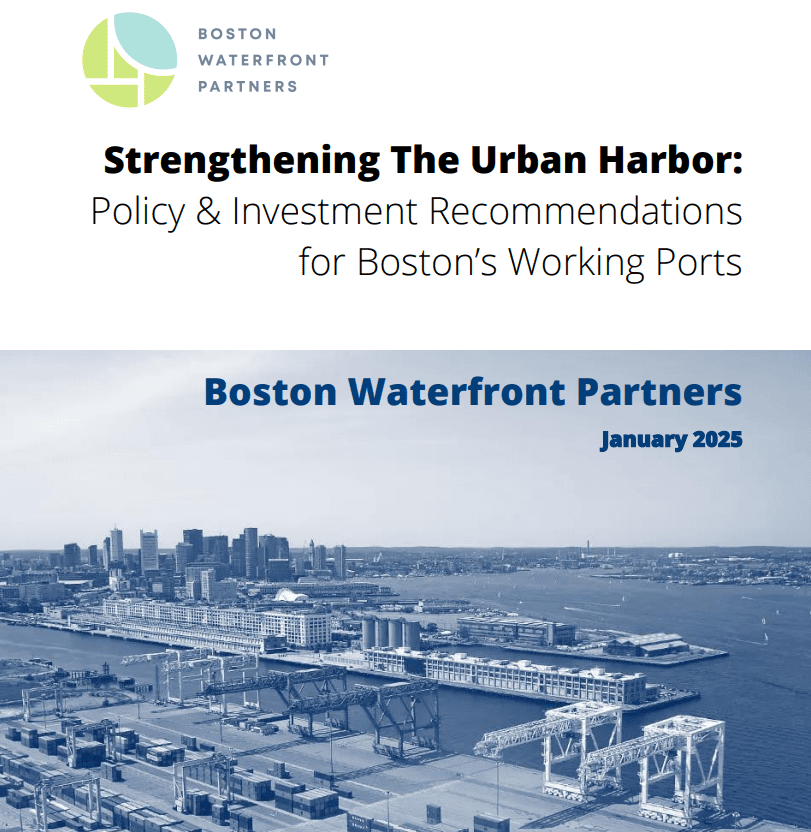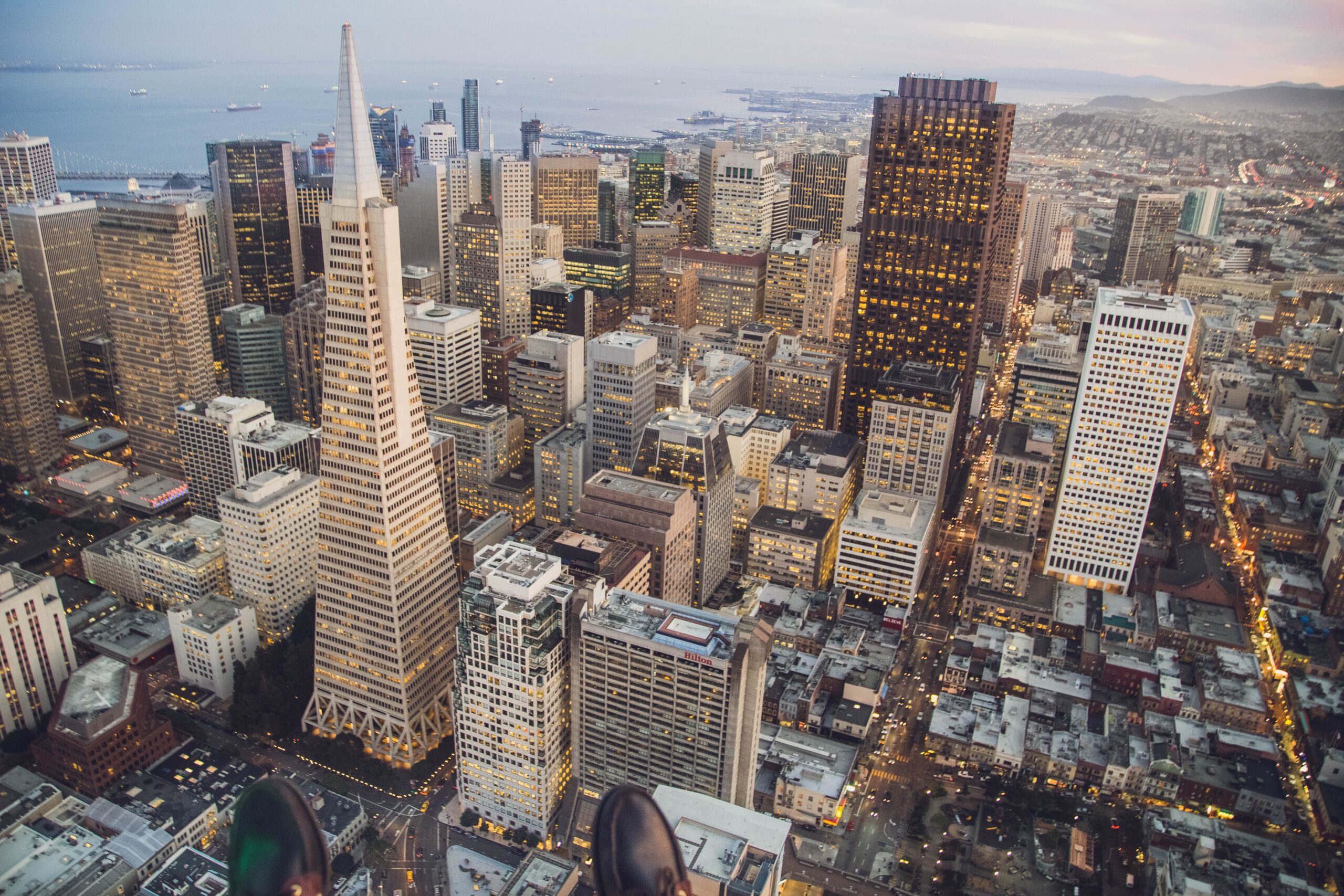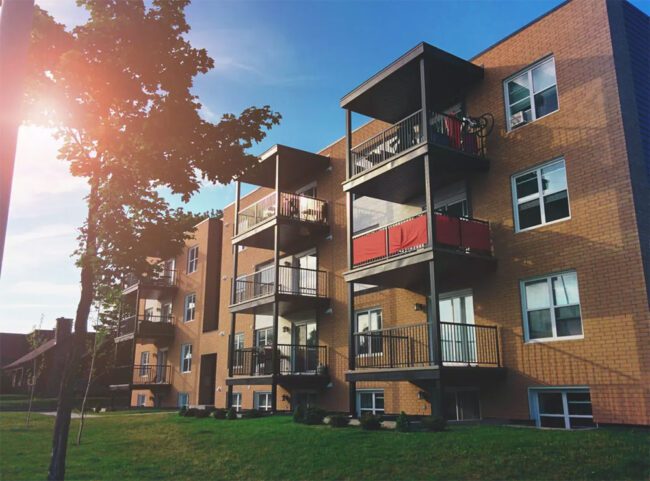This press release was originally issued by Boston Waterfront Partners.
January 29, 2025—Today, the Boston Waterfront Partners—community-based organizations dedicated to the sustainable development and equitable use of Boston’s waterfront areas—released a new report analyzing the challenges facing Boston’s waterfront and working port communities, as a result of Boston’s outdated Inner Harbor Designated Port Area (DPA) regulations. The report offers a roadmap for revisiting how DPAs can better serve the people and industries they were originally built to protect, and support the region’s evolving economic, climate resilience, and public health priorities.
Massachusetts DPAs, first established by the Office of Coastal Zone Management (CZM) in 1978, have been essential to protecting and growing the Commonwealth’s vital water-dependent industries for decades. Boston’s Inner Harbor DPAs have a critical role to play in maintaining Boston’s working port as an economic driver, protecting essential waterfront infrastructure, providing local job opportunities, facilitating water transit, and promoting climate resilient communities. Yet, 50 years after they were originally established, Massachusetts DPAs have not undergone a comprehensive review or any type of reform to ensure they are responsive to present day dynamics.
The report identifies several challenges facing Boston’s Inner Harbor DPAs, including:
-
- The regulatory frameworks governing Boston’s Inner Harbor DPAs are outdated, failing to account for the latest economic, climate, and public health concerns and realities, and leaving much of their transformative potential for communities untapped.
- Increasing and competing cross-sector pressures and priorities that are vying for use of DPAs, and utilizing regulatory loopholes to undermine them, have weakened their integrity, and strained their effectiveness.
- A lack of public-private collaboration to address the challenges posed by DPAs has hindered long-term planning and investment.
“Designated Port Areas hold massive potential to not only safeguard Boston’s existing maritime industry, but also promote an emerging and cutting-edge blue economy, drive waterfront innovation, advance environmental justice initiatives, create workforce development opportunities, meaningfully engage local communities, and much more,” said Jill Valdes Horwood, Director of the Barr Foundation’s Waterfront Initiative. “This report underscores why it is imperative that we reach this potential and reimagine the role that Designated Port Areas play, today and for future generations, in building and maintaining an economically vibrant and resilient working port, city, and region.” To address these challenges, the report recommends strategies to streamline DPA regulations, improve stakeholder engagement about decisions made in DPAs, and lay the groundwork for crucial investments in economic development and resilience. Specifically, the report calls for
Planning & Governance:
-
- Direct economic development planning and investment in DPAs by expanding and empowering the Seaport Economic Council to steward better-resourced, climate-resilient seaport development.
- Invest in the first maritime economic development plan for the harbor in nearly three decades and maintain shared, detailed data on DPA economic and land use conditions thereafter.
- Build workforce development pipelines that connect local talent, including talent in economically vulnerable communities, to high-road jobs in growing maritime industries.
Land Use & Regulatory Planning:
-
- Encourage clean fuel and electrification infrastructure in DPAs to help maritime industrial businesses and their supply chains transition to clean and renewable power sources.
- Create transitional zones to give business owners more flexibility on their properties and more effectively blend water-dependent industrial uses with other uses on the margins of DPAs.
- Establish clear and fairly enforced standards for property maintenance in DPAs, and facilitate collective responsibility for DPA property maintenance among property owners.
Climate Adaptation & Sustainability:
-
- Establish a DPA decarbonization finance assistance program to help maritime industrial businesses navigate existing financing opportunities to transition to cleaner fuels and decarbonize their operations.
- Establish a DPA resiliency grant program to help maritime industrial businesses assess their vulnerability to climate hazards and begin to fortify their assets.
- Channel reauthorized MassWorks program funds, supplemented with federal money, to advance large-scale environmental remediation and long-needed climate adaptation investment in working ports. Expanding and empowering the Seaport Economic Council to steward better-resourced, climate-resilient seaport development, investing in a maritime economic plan for the harbor, and building a workforce development pipeline to connect local talent to careers in the maritime industry.
The report, which was commissioned by the Boston Waterfront Partners and researched and written by HR&A Advisors with funding from the Barr Foundation, was developed after careful data analysis of existing regional conditions and case studies investigating innovative regulatory approaches in other port cities, as well as stakeholder interviews with community members, waterfront and environmental justice advocacy organizations, and members of Boston’s maritime and development industry.
“We are grateful to the Barr Foundation for funding this comprehensive report on behalf of the Boston Waterfront Partners. Boston Harbor is the region’s largest port, supporting critical jobs and economic activity,” said Katherine Abbott, President and CEO of Boston Harbor Now. “We are excited to use the report’s recommendations to help leverage public and private funds to support the working waterfront and create a climate-resilient coastline.”
“Massachusetts’ waterfronts have always played a critical role in the state’s economy, supporting our fishing, shipping, and energy industries, among others. But those industrial uses haven’t always benefitted the communities that host them,” said Julia Carlton MacKay, Director of Community Resilience for Conservation Law Foundation. “By reimagining our working waterfronts, we can drive innovation, create sustainable jobs, and ensure that the communities hosting these industries have a meaningful stake in their success. With the right balance, working ports can support both economic growth and environmental stewardship for years to come.”
“Kudos to Boston Waterfront Partners and their collaborators for giving us this fresh look at the importance of maintaining Boston’s waterfront vitality in the face of environmental threats and competing demands,” said Dennis Sullivan, Board Clerk and Chair of the Resiliency Committee of the Friends of the Mary Ellen Welch Greenway. “This must-read DPA report offers a model for public-private partnerships which the city needs to manage competing interests while protecting the city’s long-term interests in its core marine industry infrastructure.”
“For 30 years GreenRoots has been advocating for a waterfront that is not only accessible to the community but also contributes to its well being. This report is critical because it highlights the important and evolving role of the Designated Port Area to our coastal communities. It isimportant to recognize that as we adapt our coastal zoning policies to an evolving climate and a rapidly changing real estate landscape that we maintain equity as a guiding priority,” said John Walkey, Director of Climate Justice & Waterfront Initiatives for GreenRoots.
“It’s appropriate that the Bay State should have state-of-the-art port facilities that can support a thriving maritime industry, but those resources need to be connected to and serve the environmental justice communities in which they have been historically located, through jobs, training and public access to the waterfront,” said Chris Mancini, Executive Director of Save the Harbor/Save the Bay. “If we can assess the needs and potential in Designated Port Areas, we can drive both economic growth and public benefits for people regardless of race, language
or ability.”“This report identifies opportunities to build inclusive workforce development pipelines for traditional maritime and new blue economy jobs,” said Willie Bodrick, II, President & CEO of The American City Coalition. “Boston is overdue for a public dialogue about DPAs. To fully realize the economic potential of DPAs, we must work together to foster a connected economy and develop intentional strategies that engage residents of Roxbury and other communities of color in the waterfront workforce and blue innovation economy.”
About Boston Waterfront Partners: The Boston Waterfront Partners—a coalition of community-based organizations including Boston Harbor Now, Boston Harbor Women of Color Coalition, Charles River Conservancy, Coalition for a Resilient and Inclusive Waterfront, Conservation Law Foundation, Friends of the Mary Ellen Welch Greenway, GreenRoots, Harborfront Neighborhood Association, Mystic River Watershed Association, New England Aquarium, Piers Park Sailing Center, Save the Harbor/Save the Bay, The American City Coalition, and Trustees of Reservations—is dedicated to the sustainable development and equitable use of Boston’s waterfront areas. More information about the Partners can be found here.










